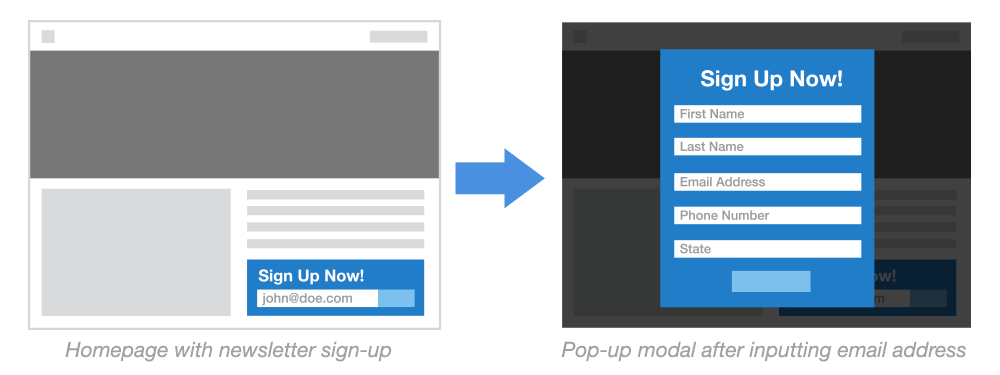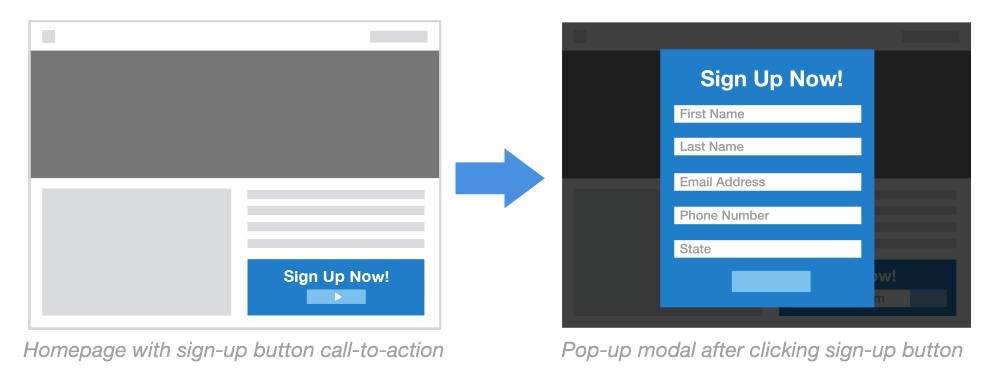Client Story
Healthcare organization discovers hidden opportunity to increase email sign-ups
CLIENT STORY OVERVIEW
A large healthcare client wanted to explore ways in which it could better engage with prospective customers. A core aspect of its engagement strategy was to encourage visitors to sign up to receive updates on insurance coverage options.
When new visitors landed on their website, they were presented with a pop-up modal asking them to sign up for coverage news and updates. The marketing team was interested in expanding and optimizing its email sign-up efforts to drive greater engagement.
CHALLENGE
Up to this point, the healthcare organization had primarily focused on generating email sign-ups through its first-time visitor pop-up modal. Its marketing team realized they were overlooking opportunities to capture email sign-ups from new and returning users who didn’t initially sign up via its modal.
Even though the healthcare organization’s website had other means of capturing emails, many of these other approaches weren’t being tracked or monitored. Without sufficient measurement in place, the organization had no idea where to focus its efforts, beyond its initial pop-up modal approach, to generate more email sign-ups.
As the organization approached its peak season for insurance enrollments, it wanted to capture more email addresses so it could engage potential customers as they weighed their healthcare coverage options.

SOLUTION
Working closely with our client, BlastX was able to pinpoint a key opportunity on its homepage. On this high-traffic page, there was a content section that prompted visitors to sign up for email notifications by providing their email address. After they entered their email address and clicked the sign-up button, a pop-up modal asked them to provide additional information such as their state and mobile number before clicking a final sign-up button. Lacking any historical data on how effective this sign-up process was, BlastX first implemented tracking to measure its performance.

After collecting data for 10 days, BlastX discovered the engagement with this sign-up feature was very low. The sign-up content only had a 0.06% clickthrough rate (CTR) from the homepage. Only 50% of these visitors filled out the additional fields and completed the sign-up process (0.03% CTR). These results indicated there was some kind of friction within the user experience. On closer examination, BlastX noticed after a visitor entered their email address on the home page, they were prompted to re-enter it on the pop-up modal, which created a redundant step. Further discovery into this sign-up process uncovered the email address wasn’t required to proceed to the next step, and the information wasn’t even stored anywhere.
BlastX hypothesized if the initial form field for the email address was eliminated and converted to a simple “sign up” button, it could streamline the entire user experience and drive more sign-ups. BlastX implemented a two-month test to verify whether this change would improve the CTR and increase email sign-ups.

RESULTS
During the course of the two-month experiment, more than 1.6 million visitors were each exposed to the control page and a new variation with the simplified sign-up button. Based on this optimization, BlastX was able to increase the overall number of email sign-ups by 37.6%.

In terms of lowering the barrier to begin the sign-up process, the new version without the redundant email address field saw a 21.6% lift in CTR for both desktop and mobile users. In addition, the modal’s email submission rate increased 15% compared to the original user experience.

Based on implementing this change, BlastX conservatively estimated the healthcare organization would capture an incremental 6,200 email sign-ups over the next 12 months.
Armed with this insight, the marketing team convinced its leadership and partner teams to implement this change immediately. In addition, it was used to help identify other similar areas of the site that could benefit from this same strategy.
PROJECT OVERVIEW
Goals- Better engage with prospects through email sign-ups
- Email sign-ups increased 37.6% over initial two-month period
- Clickthrough rate increased 21.6% for both mobile and desktop users
- Our client will capture an estimated 6,200 more email sign-ups over twelve months
- This strategy is being considered for other calls-to-action across our client’s site
- Increased the overall number of email sign-ups by 37.6%
- Email submission rate increased 15%